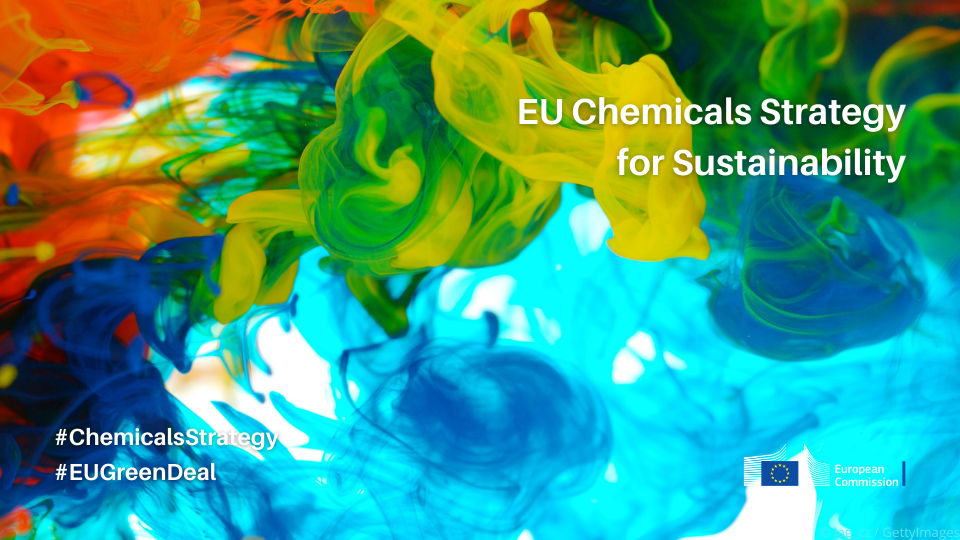TOWARDS A TOXIC-FREE ENVIRONMENT
The European Green Deal sets a high ambition for a toxic-free environment leading to zero pollution. Adopted on 14 October 2020, the European Union (EU) Chemicals Strategy for Sustainability (CSS) outlines the Commission’s strategy for the sustainable and safe use of chemicals. This initiative is part of the Green Deal and aims to better protect human health and the environment while boosting innovation for safe and sustainable chemicals.
The focal point of this initiative are cosmetic products, especially focusing on various actions and potential measures to improve the efficiency and effectiveness of the current rules on these products. Consequently, this strategy will affect the EU Cosmetics Regulation (Regulation (EC) No 1223/2009 on cosmetic products). The CSS includes an institutional commitment of the Commission to present a new legislative proposal to amend the EU Cosmetic Products Regulation.
The Cosmetic Regulation will be subjected to a targeted revision, alongside other chemicals legislation, including REACH Regulation and CLP Regulation. A feedback period for this regulation proposal was set from 4 October until 1 November 2021. The feedback will be considered for further development and fine tuning of the initiative. A synopsis report will be made by the Commission, summarizing the input received and explaining how the input will be taken into account and why certain suggestions could not be considered.
APPROACH AND OBJECTIVES OF THE CSS
According to the European Cosmetic Regulation, substances classified as CMR (carcinogenic, mutagenic or toxic for reproduction) are prohibited in cosmetic products (with exceptions, under strict conditions). Nevertheless, there are other harmful chemicals that may pose similar risks to consumers and professional users. Simultaneous exposure to multiple chemicals (from cosmetics and other sources) may also have harmful effects to the environment and humans. This problem is not currently covered by the requirements of the Cosmetics Regulation. This Regulation is not yet aligned to the approaches announced under the CSS to implement the generic approach to risk management and the essential uses concept intended to address those risks. Therefore, one of the main goals of the initiative is to extend the generic approach to risk management to ensure that cosmetic products do not contain chemicals that:
- cause cancers, gene mutations, affect the reproductive or the endocrine system (CMRs);
- affect the immune, neurological or respiratory system;
- are persistent or bioaccumulative;
- are toxic to a specific organ.
Extension of the existing and modified provisions restricting CMRs (Article 15 of the Regulation) will be analysed, exceptions’ criteria and processes will be revised and provisions to take account of combination effects will be introduced.
The European Commission’s Scientific Committee on Consumer Safety (SCCS) is responsible for conducting the risk assessments of substances in cosmetics. The CSS wishes to reattribute assessments of substances also used in cosmetics to an EU Agency (e.g., ECHA, new working group of RAC, other independent committee). The CSS approach “One Substance, One Assessment” aims for a better effectiveness, efficiency and coherence of the safety assessments, using the best expertise and resources available in the agencies.
This initiative considers that the EU chemicals legislation needs to use coherent terminology when it comes to the definition of nanomaterial and that this definition should be reviewed and aligned with the outcome of the comprehensive review (Review of the Recommendation 2011/696/EU) taking place in the context of the CSS.
Simplification and digitalization of labelling requirements of chemicals is also taken into account by the CSS initiative, in order to improve the communication of essential information on chemicals. The use of digital tools for product labels is an option.
If you wish to get more information on this subject and the implications of this EU initiative, feel free to contact us at info@criticalcatalyst.com.
References:
- Regulation (EC) No 1223/2009 of the European Parliament and of the Council of 30 November 2009 on cosmetic products.
- Inception Impact Assessment. EU Chemicals Strategy for Sustainability – Revision of the Cosmetic Products Regulation. European Commission. 04/10/2021.
- Review of the Recommendation 2011/696/EU – Stakeholder consultation. European Commission. Available from: https://ec.europa.eu/environment/chemicals/nanotech/review_en.htm















